#Bats And Agriculture
Explore tagged Tumblr posts
Text
Bats are not evil after all
We're wrong about bats🦇. They're not bloodthirsty monsters🧌 who won't convert you into vampires 🧛 They're productive for the ecosystem as power pollinators.
#Bats power pollinators#bats#Ecosystem#Bats Pollinators#Ecosystem Heroes#Night Pollination#Bat Conservation#Seed Dispersal#Environmental Benefits#Agave Pollination#Cacti Pollination#Fruit Bats#Nature's Pollinators#Biodiversity#EcoWarriors#Bat Habitat#Sustainable Ecosystems#Bats And Agriculture#Nature Balance#Bat Pollination#Vital For Environment#protect Bats
0 notes
Text

page 564 panel a - I sound so lame! The ideas are valid but my writing is so BORING.
I miss the good old days when I would write is that a bat? under an array of data lines that may or may not have looked like a bat. And maybe I would say something about the Lapp School of Economics use of the bat in their divination rituals, more animist than economist.
#economics#economists#economy#a dynamic modelof corn production sales and prices#prices#sales#dynamic#corn#agriculture#heartland#sellers of corn#lapp school#lapps#lappland#finland#animism#pagan#wiccan#witchcraft#bat#carlsbad caverns#chiropterology#chiroptera#flying fox
7 notes
·
View notes
Text
Out of Sight, Out of Mind: The Unexpected Importance of Bats, Past and Present
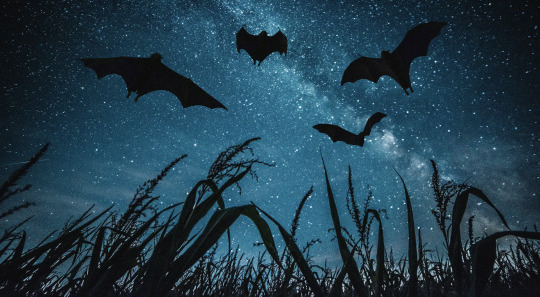
Throughout history, bats have been associated with vampires and the macabre, but did you know that bats also play a crucial role in the history of agriculture?
Many bats help to reduce crop damage by preying on pest and their droppings “Guano” are a rich source of fertilizer used through history to increase crop yields. Bats are considered to be farmers allies. Some bats also play an important role in pollinating crops. Several species of bats feed on the nectar of flowers, and as they move from one flower to another, they transfer pollen, helping to fertilize the plants. This is particularly important for plants that rely on bat pollinators, such as agave, which is used to produce tequila.
Guano is a valuable natural fertilizer that has been used by humans for centuries. It is rich in nitrogen, phosphorus, and potassium, which are essential nutrients for plant growth. In fact, bat guano was one of the earliest natural fertilizers used in agriculture, and it is still used today by organic farmers and gardeners. However, over time, the collection of bat guano for commercial use has had negative impacts on bat populations.
Guano is also important for the preservation of caves. It provides a nutrient source for the ecosystem, supporting the growth of bacteria and fungi that break down organic matter and recycle nutrients. In addition, bat guano can help to stabilize cave sediments and prevent erosion, which is important for the preservation of archaeological and paleontological sites.
Guano is a very slow to recover natural resource. Excessive harvesting for agriculture has disrupted the delicate balance of the ecosystem in many places, leading to a decline in the biodiversity that supported bat populations. In turn, the benefits from those bats have disappeared.
Bats provide a valuable ecosystem service by controlling pests and fertilizing crops, their conservation should be a priority for farmers and policymakers. By adopting bat-friendly farming practices, such as providing bat roosts and protecting bat habitats, farmers can help to ensure the continued success of agriculture, while also supporting the conservation of these important animals.
As it comes to renewable resources, it’s to be responsible with our consumption. The cascading effects of over consumption are complicated and often unexpected. Like with bats, our lives are tied to the healthy functioning of the ecosystem in ways we often don’t think of. Small acts, whether good or bad, can have profoundly larger impacts.
#life after life#conservation#green burial#sustainability#symbiosis#biodiversity#bats#farming#agriculture#plants#pollinators#guano#caves#cemetery#death positive
14 notes
·
View notes
Text
This applies to tequila as well btw!
Check out Tequila Interchange Project - supports and promotes sustainable and ethical agave farming :)
my poison ivy hot take is i actually think she would be some kind of weird carnivore rather than a vegetarian because she only really has empathy for plants and sees most people as meat sacks i think she would eat people is what i'm saying. what i'm saying is they should let her do sexy lesbian cannibalism
18K notes
·
View notes
Text
Vertebrate 3D scan project opens collections to all - Technology Org
New Post has been published on https://thedigitalinsider.com/vertebrate-3d-scan-project-opens-collections-to-all-technology-org/
Vertebrate 3D scan project opens collections to all - Technology Org
A venture to digitize vertebrate collections in museums and make them freely available online for anyone to access has reached a milestone. The project has created 3D CT scans of some 13,000 specimens, representing more than half the genera of birds, amphibians, reptiles, fishes and mammals.
Lateral view of piranha (Serrasalmus iridopsis); collected in South America, by C. F. Hartt who died in 1878. The exact year of collection is not known, but was likely in the latter half of the 19th century.
The project, the oVert (openVertebrate) Thematic Collection Network, has just wrapped up a four-year, $2.5 million National Science Foundation grant, with the efforts to date described in a paper published in BioScience.
The Cornell Museum of Vertebrates, one of 18 institutions taking part in oVert, has uploaded roughly 500 CT scans of specimens from its collections. The museum holds approximately 1.3 million fish specimens, 27,000 reptiles and amphibians (collectively called herps), 57,000 birds and 23,000 mammal specimens.
“Not everyone is interested in making a trip to a museum, so by digitizing specimens, placing everything up on a website and making it free, anyone who wants to access it can without having to leave the house, which allows for much more equitable access,” said Casey Dillman, curator of fishes and herps at the Cornell Museum of Vertebrates in the College of Agriculture and Life Sciences, and a co-author of the Bioscience paper.
So far, users have included artists, high school and college students, educators and scientists.
oVert allows the natural history collections that are represented to be used in collaborative ways, such as in classrooms. The format has made it simpler to compare anatomies of different species.
“You can do so many things,” Dillman said. “You can compare specimens and look at the evolution of limbs, or wings in birds and bats, or gills in fishes.”
Views of a juvenile pied-billed grebe (Podilymbus podiceps) that perished swallowing a fish.
One limitation of the platform is that each specimen dataset can be 2 to 3 gigabytes in size, requiring users to have access to a computer with an expensive graphics processor to visualize the data. “Not everyone’s laptop can do that,” Dillman said.
Dorsal view of a shovelnose sturgeon (Scaphirhynchus platorynchus); one of the three species of shovelnose sturgeon in the U.S. The other two species are federally endangered. This specimen was collected in 1909 in Emanuel Creek at Springfield, South Dakota. Image credit: Cornell University Museum of Vertebrates
The idea behind the grant was to CT scan one species of every genus of vertebrate, thereby building an online digital library of each organism’s appearance – its phenotype, or observable characteristics – with respect to the skeletal anatomy. While most of the images are skeletons, some were stained with a special solution to provide better contrast and visualize soft tissues, such as skin and muscles. The scanners use X-rays, which can be set as weak as a medical X-ray for soft tissue, or strong enough to view through rocks and fossils.
Museum catalog numbers included with each image link to the institutional database where the specimen originated. Database entries include when, where and by whom a specimen was collected.
Lateral view of a sargassum fish (Histrio histrio); collected from the south shore of Boca Chica Bay in Monroe County, Florida, in 1979. Image credit: Cornell University Museum of Vertebrates
In many ways, the oVert project is just getting started, Dillman said. “Thirteen thousand species isn’t even scratching the surface of vertebrate diversity,” he said.
For example, there are more than 36,000 species of fishes alone; one species per genus is a good start, he said, but it will take time and additional funds to represent the great depth of diversity.
“If you think about some of the fish lineages in North America, there might be 200 species within a genus,” he said.
Each round of funding will allow the teams to continue representing more genera and adding more species from each genus.
The grant’s principal investigator was David Blackburn, curator of herpetology at the Florida Museum of Natural History in Gainesville, Florida.
Source: Cornell University
You can offer your link to a page which is relevant to the topic of this post.
#000#3d#3D scanning#agriculture#America#amphibians#Anatomy#artists#bats#birds#Building#collaborative#Collections#college#computer#data#Database#digital library#diversity#Evolution#fish#Fossils#Foundation#Funding#graphics#History#images#it#laptop#life
0 notes
Photo

Dying Bats Threaten Organic Agriculture
0 notes
Text
notice how the animals christians deem as evil are bc they’re in an environment where they cant personally profit from the land by virtue of the animals presence and need to try to give a moral reason to extinguish them so they can take the land
#wolves? they have territories!#bats? they have specific trees and caves and places they sleep that you cant just put fucking dirt over and call it a day!#snakes and spiderS? they make the area Unappealing To Be In And Scawwy#yeah scary to you bc every animal sees you as a threat immediatly#because you fucking are#i was walking in the woods yesterday and i almost pushed away a branch before noticing a really cool jumping spider that just sat there and#let me admire it. but im sure for yall you'd never even get the chance bc most animals go into fight or flight mode#since ALL you want to do is fucking take and pretend you're owed their land for whatever fucking reason#oh yeah? its for profit. i forgot. i mean. after all christianity only exists because of agriculture and a group of people trying to#justify why they get to hoard all the abundance of food and wealth for themselves.#surely those same people wouldn't also then look for more land and try to find moral reasons to take it with their new totally moral system#that arbitrarily designates them More Worthy
1 note
·
View note
Text
"Abby Allen has no problem with her neighbours peering over her luxuriant hedges to see what she is up to on her farm.
For years she has been carrying out ad hoc experiments with wildlife and farming techniques; in her lush Devon fields native cattle graze alongside 400-year-old hedgerows, with birds and butterflies enjoying the species-rich pasture.
Under the environmental land management scheme (ELMS), introduced by the government in 2021, those experiments were finally being funded. “We have a neighbour who has always been more of an intensive farmer,” she says, but he is now considering leaving fields unploughed to help the soil. “It genuinely is having such a huge impact in changing people’s mindsets who traditionally would never have thought about farming in this way.”
The new nature payments scheme followed the UK’s exit from the EU, when the government decided to scrap the common agricultural payments scheme, which gave a flat subsidy dependent on the number of acres a farmer managed. In its place came ELMS, which pays farmers for things such as planting hedges, sowing wildflowers for birds to feed on and leaving corners of their land wild for nature.
But these schemes are now at threat of defunding, as the Labour government has refused to commit to the £2.4bn a year spending pot put in place by the previous Conservative government. With spending tight and the chancellor, Rachel Reeves, cutting back on infrastructure and hinting at tax rises, a cut to the ELMS scheme may be on her list.
However, government data released last week found the schemes were working to tentatively bring nature back to England’s farmland. Butterflies, bees and bats are among the wildlife being boosted by ELMS, with birds among the chief beneficiaries, particularly ones that largely feed on invertebrates. An average of 25% more breeding birds were found in areas utilising the eco-friendly schemes.
...there are also farmers who welcome the schemes. Allen says the ELMS has helped her farm provide data and funds to expand and improve the good things they were doing for nature. “Some of the money available around things like soil testing and monitoring – instead of us going ‘we think these are the right things to do and providing these benefits,’ we can now measure it. The exciting thing now is there is money available to measure and monitor and kind of prove that you’re doing the right things. And so then you can find appropriate funding to do more of that.”
Allen, who is in the Nature Friendly Farming Network, manages a network of farms in England, most of which are using the ELMS. This includes chicken farms where the poultry spend their life outside rather than in sheds and other regenerative livestock businesses...
Mark Spencer was an environment minister until 2024 when he lost his seat, but now spends more time in the fields admiring the fruits of his and his family’s labour. He says that a few years of nature-friendly agriculture has restored lapwings and owls.
“On the farm, I haven’t seen lapwings in any number for what feels like a whole generation. You know, as a kid, when I was in my early teens, you’d see lapwings. We used to call them peewits. We’d see them all the time, and they sort of disappeared.
“But then, me and my neighbours changed the way we did cropping, left space in the fields for them to nest, and suddenly they returned. You need to have a piece of land where you’re not having mechanical machinery go over it on a regular basis, because otherwise you destroy the nest. We’ve also got baby owls in our owl box now for the first time in 15 years. They look mega, to be honest, these little owls, little balls of fluff. It is rewarding.”"
-via The Guardian, August 23, 2024
#rewilding#nature#sustainability#endangered species#birds#wildlife#england#uk#uk politics#farming#sustainable agriculture#good news#hope
554 notes
·
View notes
Note
Hi Gallus, I'm doing some worldbuilding and you seem like you could be connected enough for me to find an answer to the problem of dwarven agriculture. Many problems are created by the requirement of no sunlight, as even the common response of mushrooms still need light to break down decomposing matter as a primary energy source. Currently, we're thinking that they use a special type of mushroom that breaks down rocks in an energy-producing reaction, giving them enough energy to absorb nutrients and grow - this would serve a second purpose in explaining why building a massive hollowed-out mountain fortress doesn't produce an equally large amount of gravel.
Any thoughts? We're grasping at straws kinda lol
Well, some thoughts:
There's plenty of cave systems (especially Karst Systems) that are at least partially open to Sunlight- especially the kind that have rivers running through them, which is something else that's really helpful for agriculture.
For Example: This Cool AF Sinkhole cave in china that has an entire Forest in it
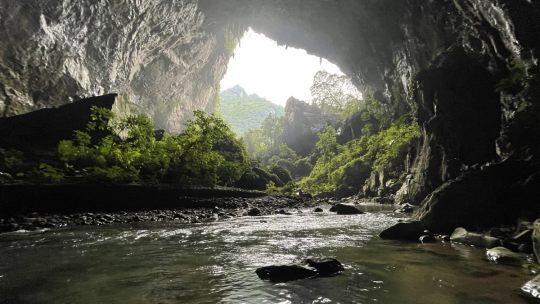
Now There's a view to put outside the city Gates!
Karst specifically is a landscape where underground rivers hollow out the limestone underground and then the cave roofs fall in. This kind of landscape answers your gravel question nicely: the hollowed out mountain does produce an equal amount of gravel, but the gravel turns up as the sandy banks of the river system hundreds of miles away.
So, there's your sunlight that can be used directly, or reflected or magically transferred deeper into the cave system.
Or they just put more holes in the roof! Unless your dwarves are also vampires, there's no reason for them to not hollow out a few Skylights into the mountain too.
But let's talk some other cave ecology and agriculture!
For starters, your dwarves could be sitting on top of a literal gold mine that would allow them to trade for a lot of needed materials and crops.
And by gold mine, I mean Salt Mine.
Historically, salt comes out of hollowed-out mountains and is worth more than gold.
Also something the humans have historically fought a bunch of wars over, so there's some free political tensions if you needed that!
I can also mean the possible fucking enormous piles of bat guano that accumulates in Karst caves, which is the world's most insanely good fertilizer, and ALSO something that has been worth more than it's weight in gold.
Speaking of Gold, another thing that often lives in sinkhole caves in abundance is BEES. turns out, limestone stalactites are a terrific place to build a hive that is difficult for predators to reach, stays dry and the stone substrate means the hives can reach many tons in weight before they start having structural issues. That sweet, sweet insect-derived liquid gold is already important to Dwarves in a lot of folklore- it's really hard to have a Traditional Dwarven Mead Hall without the honey to make the mead, you know?
So you got your mushrooms, you got your sunlight-grown sinkhole crops, you got your traded goods and you got your source of alcohol- the only thing really missing from an ancient food pyramid here is a staple carbohydrate. To that end, may I propose our good Peruvian Friend: The Potato.
Grain crops aren't actually all that nutritious and were kept around in ancient societies more as legal tender that kept the peasants busy, because wheat or rice takes months to grow, an enormous amount of labor to harvest, and wheat also needs to be milled before it can be turned into food- all enormously time-consuming processes that keep peasants busy and easy to rule tyranically over.
Potatoes though? Pop one in the ground in spring and you can dig up fingerlings all summer, and if you make potato towers, you can harvest up to 40lbs of delicious, easy-to-prepare-and-store carb out of a single plant- a real space-saver for the limited sinkhole skyspace.
If your dwarves have cheese, the potato makes even more sense, because Potato+dairy is the easiest, most nutritionally complete survival food there is.
Finally, consider: Dwarven Vodka.
This post is open for anyone to comment suggestions on, but that's my take: put your dwarves in a Karst-sinkhole cave system, give them a highly in demand resource like salt or guano, bees, and taters. Boom. Whole agriculture, economy and political scheme starters.
1K notes
·
View notes
Text

݁݁˖ ❀ ⋆。˚ Lady Persephone… Yesterday was Lady Persephone’s worship day. Because I hadn’t gotten much sleep the previous night, I completely forgot to make a post for her. I hope this helps teach you how to worship Her and Her mythology. ✾ Who is Persephone? Persephone is the daughter of the Olympian Gods, Zeus, and Demeter, she is the Goddess of spring, agriculture, reincarnation, and Queen of the Underworld; She is widely associated with growth, fertility, and love as well as everlasting pureness/youth. Her most famous myth is Her abduction by Hades, Her husband/uncle. ✾ Mythology. After Persephone was born, Her home was the Overworld alongside her mother Demeter. While she was picking flowers alongside the spring nymphs, the earth opened and She was abducted by Hades on His chariot. After Her abduction, Demeter struggled to keep up her divine duties and the earth started to die without Persephone, due to this, Hermes was sent to the Underworld to collect Persephone but before She left the Underworld; Hades tricked Persephone into eating pomegranate seeds. Due to this, Persephone now spends half the year in the Overworld and the other half in the Underworld which explains the seasons. Depending on the myth, Persephone is the mother of Dionysus after Zeus assaulted Her, however, the myth was changed later on as the ancient Greeks believed that having their chief God assaulting His daughter was too evil of Him. Nowadays, Dionysus was changed to Zagerus and He is known to be Hades’ son instead. Melionë was also a result of Zeus assaulting His daughter as He tricked Her by disguising Himself as Hades, although, modern interpretations of the myth have Hades be Her father, like Zagerus. Persephone also was associated with the Orpheus and Eurydice myth; when Orpheus descended into the Underworld to retrieve Eurydice, he managed to make a song so beautiful and heartbreaking that Hades became sympathetic toward him and offered Orpheus that he could take Eurydice back but the catch was he wasn’t allowed to turn back to see if Eurydice was behind him or even touch her to lead him out of the Underworld. Hades did this to test Orpheus’ love for his wife and how much he cared for her.
✾ Symbols and Offerings. Symbols: -Pomegranate. -Torches. -Seeds. -Flowers. -Skulls. -Bones. Offerings: -Any type of flowers (can be fake). -Pomegranate (fake, scents or food). -Found bones (Remember to thank the animal and leave an offering for them as a way of respect). -Tarot decks you associate with her. -Nuts and seeds. -Fruit. -Anything with grains. -Anything minty. -Jewellery. -Poetry or any kind of art related to Her. -Floral/fruity scented candles. -Dried herbs or flowers. -Crystals: angel aura quartz, rose quartz, and opalite. -Drinks like tea, hot chocolate, water, milk or honey. -Bat, ram, deer or dog imagery. Persephone shares an altar with Lord Hades so if you wish to see altar inspiration, here is the post I made for Hades: https://www.tumblr.com/al0v3w1tch/766671508589477888/%E0%BD%90-%E0%BD%8B-lord-hades-today-is-lord?source=share ✾ Prayers. -Fair-haired Persephone, daughter of Demeter, friend of the nymphs, merry-hearted girls who dance bearefooted and play, carefree, in grassy fields, wreathed in bright spring flowers.
The joy of life is yours, goddess, the comfort of sun on skin, the dear bonds of friendship, the refuge of a mother’s love.
Well-crowned Persephone, bride of noble Hades, queen of the afterworld, clothed in fine silks, adorned with jewels, enthroned in glory, friend to those who have passed from this world into yours, advocate of the dead and the wronged.
Kindly Persephone, womanly one, of transformation do you know much, of the ways of the earth do you know much; of the life after life do you know much.
Gracious goddess, friend of mortals, I praise you and thank you for your gifts.
-Persephone, glorious goddess, fair one with hair that flows like ripened grain, eyes that catch the clear blue sky, a smile sweet yet shadowed, O light-footed one who dances in flowered fields, I praise you.Persephone, lovely one who knows the feel of sun on skin, who knows as well the press of cold stone against warm flesh, in the world of the living, no maid is so alive as you.
In the world of the dead, Persephone, you reign as queen, crowned with riches unsurpassed, enthroned in splendor, honored above all others.
Goddess, child of earth, bride of the darkness, I honor you. -Persephone, glorious goddess, fair one
with hair that flows like ripened grain, eyes that catch
the clear blue sky, a smile sweet yet shadowed,
O light-footed one who dances in flowered fields,
I praise you. Persephone, lovely one who knows
the feel of sun on skin, who knows as well the press
of cold stone against warm flesh, in the world
of the living, no maid is so alive as you.
In the world of the dead, Persephone, you reign
as queen, crowned with riches unsurpassed, enthroned
in splendor, honored above all others. Goddess,
child of the earth, bride of the darkness, I honor you. ✾ Blessed be.
#paganism#hellenicpaganism#pagan#hellenicpagan#witch#witchcraft#aphrodite#hades#persephone#apollo#dionysus#hestia#greek deities#hellenic polytheism#persephone worship#witchcore#witchblr
183 notes
·
View notes
Text
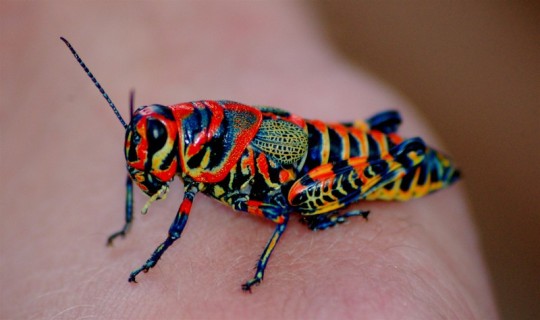
Rainbow Grasshopper (Dactylotum bicolor)
Habitat & Distribution
Mainly found in prairies and agricultural areas
Local to the Great Plains and southwestern United States
Physical Description
Weight: 0.01 oz (0.28 g) on average
Length: 20 mm to 35 mm (0.8 to 1.4 in)
Both sexes have a black base and brightly colored markings over their head and body; these markings can be red, orange, yellow, green, or blue
The rainbow grasshopper does not have wings, and moves only by hopping
Behaviour
Adults feed on a variety of plants, primarily grasses and young shoots
Though not formally social, they tend to congregate in groups for foraging
Predators include possums, raccoons, shrews, foxes, and bats
Key Advantages
Like other grasshoppers, the rainbow grasshopper has a powerful jump
The bright coloration may warn away potential predators, as they mimic other insects which are poisonous
Photo by Jay Iwasaki
432 notes
·
View notes
Text
Saturn + Saturn Placements

Hey you guys! Let’s talk about Saturn for a little bit. It’s a full Moon in Capricorn so let’s talk about her ruler. So get comfy, grab a snack and your favorite drink because this will be a long post
As a cap stellium, I’ve gotten to really know and deeply understand Saturn over the years!
I feel Saturn is misunderstood a lot in this community!
Saturn is Not the bad guy! Honestly without Saturn, your life would be in chaos! Saturn brings law and order into our lives.
Saturn delays but never denies!
Saturn is the stern parent that wouldn’t let you go to that one friends house but you rebelled and went anyway. Only to find out that one friend was never really your friend and you realize the stern parent was right.
-Saturn rules both Capricorn, Aquarius and is exalted in Libra. Saturn creates the rules for structure and order (Capricorn). Saturn can also break and create new rules for the betterment of society(Aquarius). He makes sure the rules are in balance and fair for all(Libra)
-Saturn rules over all things Government related. A lot of politicians will have Aquarius/11h, Capricorn/10h or Libra/7h placements in there . Saturn transits show us the energy of what the politics is going to look every 2.5 years.
Example: so I’m in the US, so with Saturn in Pisces, there’s a strong level of uncertainty, it’s hard to tell what’s going to happen since it’s an election year. The mental health of both candidates are being questioned, as there age. All very Saturn Pisces. Pisces rules over fog, health and uncertain energy. Saturn rules over age.
- The colors Black, Brown, Earthly Greens are Saturn colors
-Saturn rules over time. You know the phrase “All good things take time.” Saturn is ruled by Greek God Kronos who is considered “the God of time.”
-Capricorn is actually a feminine sign not masculine. It’s really funny when it’s called the “daddy” sign when it’s really “big mama”😅 keep in mind, feminine doesn’t equate to woman in Astro , it’s an energy!
- Saturn rules over these animals: Goats, Crows, Ravens, Bats, Eels, Owls, Crocodiles, Donkeys, Snakes, Camels, Beetles, poisonous animals, black colored animals/insects, domesticated Cats, and Buffalos.
- Saturn rules over these places: dry places like the dessert, low humidity, mountain locations, cold places, thick forests, underground places, caves, barren places. It also rules over graveyards, tombs and old temples. Government related buildings is also ruled by Saturn.
- Saturn traditionally rules over death. Pluto is the modern day ruler but Saturn also rules it. “Death is like meeting an old friend” that doesn’t sound like Pluto does it?😅 Saturn rules over time, when your time is up…
- A lot of people don’t know this but Saturn rules over weed not Neptune. Saturn rules over agriculture in general. Weed is a natural plant that takes time to grow and needs to processed. Neptune rules the actual high of the plant when you smoke it.
-some other plants Saturn rules is the Oak and Willow Trees.
- another thing people don’t know about Saturn is that it rules your hair not Venus. Saturn rules hair follicles and the texture of your hair. Aspects to it can show what type of hair you have. Venus is how you take care of your hair such as shampoos, conditioners, oils, hair styles etc..
Personal example: I have Saturn Aries, my hair is really thick and tightly curly. My hair fits on my head like a big helmet😅 i don’t even wear a hat in the winter because how thick it is😭I have to constantly keep it moisturize because it gets dry and itchy quick!! Summer months is never a fun time😂 I have a lot of Saturn aspects so I can make a whole post about my hair by itself LOL
-Saturn rules your teeth and bones.
- your Saturn placement can show you what your elder years will look like. That’s because it rules over the elderly.
-if you feel like you’re losing control of your life, you can tap into your Saturn energy to get it back.
Personal example: I have Saturn Aries, so when life feels like I’m out of control, I start to look at myself and what do I need to do with myself. I start making bold decisions about what I need to do! Aries is Mars energy and rules “thyself”
-Capricorn Suns can have a tough relationship with their father. Their father may have put lots of pressure on them to be the best or they want their child to be like them in some way, which makes the child feels restricted in showing their true personality. A lot of cap suns may have an absent father or father that was physically around but not emotionally around. These natives were born during a time when the father was either achieving something great or they missed an opportunity so they want their child to do it for them. This results in cap suns becoming workaholics and wanting achievements in their life.
-Capricorn Moons can also have this energy but it’s a little different. Capricorn Moons are born into families that put lots of pressure on them to be great but don’t fully believe in their success. Capricorns have big dreams that seem unrealistic to others especially family members. So they work hard, they’ll climb biggest mountain and they don’t care how long it takes because they know it’ll be worth it in the end. They may be the ones who creates a lasting kegacy in their family.
-Aquarius Sun may have more of a friendship type of relationship with their father. “That’s my buddy” type of energy between them. On the flip side, their dad may have been distant towards them. They were born during a time when their father was going through something and it made them feel distant. Their fathers could’ve had gained a new friend group. One of his friends could be these natives godparents or play uncle.
- Aquarius Moons come from family that’s emotionally distant or feel stagnant in some way. Their family probably feels more like a friend group than your “traditional family” they are here to gain freedom away from their family, do things outside the box of the traditional family . They are the black sheep of the family and may have a different vibe to them compared to their family all together!
I will end it here but I will continue to talk about Saturn for the next few days
#astrology#astrology community#knowledge#astro observations#love astrology#advanced astrology#kakiastro#tropical astrology#birth chart#Saturn series by kakiastroe#Saturn
397 notes
·
View notes
Text
~ Headcanons for twst characters playing Minecraft.
Another parts about:
Idia and Malleus!
Riddle and Leona!
Jade and Floyd!
[Azul]

Headcanon, what if Idia and Yuu somehow convinced Him to play minecraft, Azul...:
1) "Why are there cubes everywhere??? I don’t understand anything...."
2) When he learns that monsters are appearing in the dark, he places two stacks of torches around himself in horror.
3) Crying from the physics of trees.
4) Will try to make a copy of Mostro in Minecraft.
5) He does not like to dig in mines and fight, but prefers to engage in agriculture, construction and trade.
6) He built his own village, with a complex hierarchy, its own economy and an underground mafia, where he keeps all the villagers under iron grip.
7) Every five minutes:
<Octo_businessman> fell from a high place.
<Octo_businessman> tried to swim in lava.
<Octo_businessman> was blown up by creeper.
<Octo_businessman> was drowned.
<Octo_businessman> starved to dead.
8) If one of the players hits or kills an squid in front of Him, He will take it as a personal insult.
9) The only one on the server who goes to bed on time and swears at everyone in the chat, because he cannot miss the night while others are awake.
10) Chief of food, armor and potions (Not for free, of course)...
11) Tries to negotiate with the pillagers.
12) Most likely, his house is either a clumsy box decorated with vines and blue flowers, or a huge penthouse with twenty rooms. There is no middle ground. Also, it seems to me that his house would be somewhere on the beach, or in the middle of the lake.
13) Drowned people are his worst enemies.
14) Makes secret chests with all sorts of treasures that he clearly does not intend to share.
15) Already dug up all the gold and ransacked all the treasuries, while the others fought with the ghasts and withers.
16) He comes into the game the least often, because “I actually have my fill of things to do.”
17) He is afraid of dolphins, because he personally knew real ones and knows that they are not the friendliest guys (No, seriously. Dolphins are assholes. Just Google it).
18) Terrible in PVP and always dies first.
19) He says that He doesn’t care about griefers and considers their tricks to be child’s play, but in reality, he is very offended and complains to Yuu in PM on discord.
20) Likes to play in small groups of 2-3 people and does not like to play alone or with too many players.

(A SMALL UPDATE! Previously, this post was dedicated only to Azul, but I decided to make two characters for each post, for beauty, so I'll add another Lilia from the request here.)
[Lilia]
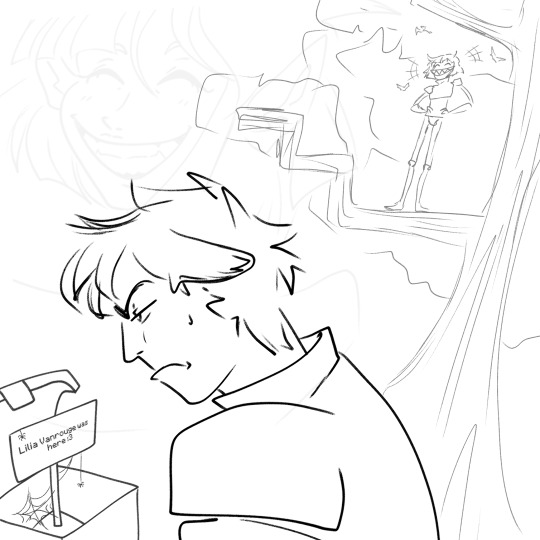
Lilia has been familiar with Minecraft since the game's inception:
1) "Ha-ha, I love adventures!"
2) Competes with Idia, who spends more time in the game and brazenly takes advantage of the fact that fairies do not need sleep as much as people (even the cursed).
3) Daddy's house is either a cave full of vegetation and bats, or there is none at all, since Lilia prefers to roam the entire server. Usually wanders the world on a fast black horse in leather armor painted green, but often runs on His own two feet.
4) He named His horse Samson.
5) He is constantly accompanied by bats.
6) During His adventures, Lily has found many interesting resources and items, and in order not to carry everything with Him, He makes ingenious warehouses with traps, which the entire server covets.
7) Sometimes takes other players on His campaigns. For example, Malleus, Sebek, Silver, Idia and Yuu.
8) Thunderstorm of PVP. Want to fight Him? Good luck.
9) Seriously... You will need luck VERY much.
10) His favorite biomes are forest ones. He hangs out especially often in Taiga and Tundra.
11) The second admin and dad of the server, who suggested Idia the idea of creating a world for the rest of the Twst guys.
12) The most secretive player on the server after Idia. In most cases, He disappears somewhere far, far away, but occasionally, He can be found bargaining with other players, sitting in a tree, or on a campaign. He also likes to play pranks and make fun of other players.
13) For some reason, all the monsters in the area ignore Him, or quickly run away.
14) Collects records (He especially likes "Ward" and "Pigstep").
15) His favorite soundtracks from the game are "One More Day" and "Firebugs".
16) Lilia has already cleared out all the treasures, sunken ships and pyramids, and in order to further annoy other players, He usually leaves signs next to the empty chests saying “Lilia Vanrouge was here :3”
17) Didn’t go to the End because caught flashbacks because of the dragon.
18) Was the one who informed Malleus that a dragon egg cannot be hatched and raise a baby dragon, and without knowing it, he regrets it.
19) Helped Idia find suitable mods for hatching and taming the dragon :D
20) "Silver, bring Your old man a glass bottle of water..."
...And then He goes off to brew an invisibility potion so he can shoo away and banter other players around with an evil giggle.
If you like My post, please reblog Me! :3
Also, if You want a doodle and headcannons for some other twst character, I will be happy to answer Your requests. They are open :D
#art#мой арт#artists on tumblr#memes#twisted wonderland#twst#azul ashengrotto#twst azul#twst memes#twst yuu#twst idia#azul x reader#twisted wonderland azul#azul ashengrotto x yuu#azul ashengrotto x reader#minecraft#twst headcanons#headcanon#reblog me#funny#lilia vanrouge#twst lilia#twisted wonderland lilia#chapter 7#general lilia#lilia headcanons
298 notes
·
View notes
Text


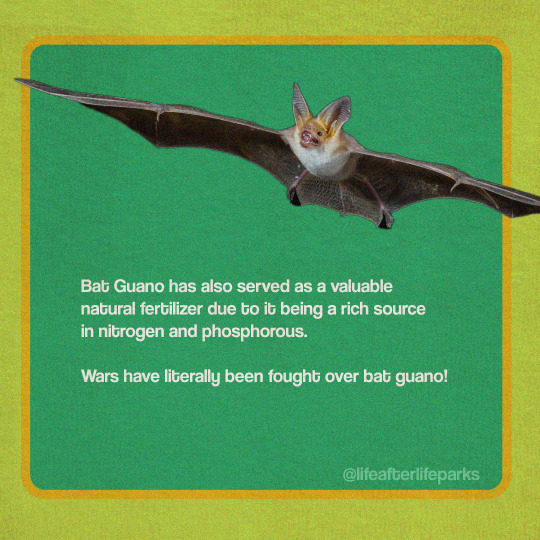


#life after life#bats#bat#batfacts#agriculture#naturalburial#naturefact#conservation#biodiversity#symbiosis#we build parks#parks for life#cemetery#funeral#memorial#sustainability#sustainable living#ecosystem#guano#plants
2 notes
·
View notes
Text
So little speculation/theory on what god Seiko may mainly serve, which I'm not a 100% on but there are some details that do stand out to me that offer it as a possibility.
The thought is that Seiko may be a medium in service to (mainly) Inari Okami.
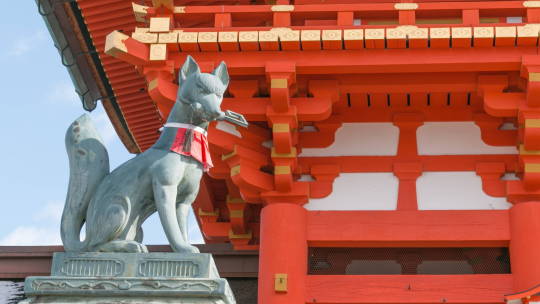
One of the big stand out details to the Ayase residence is that they live around rice fields, which rice is a major food item tied to Inari and even relates to their namesake and ties to agriculture.

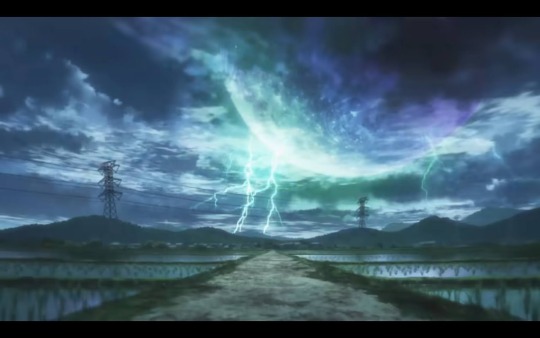
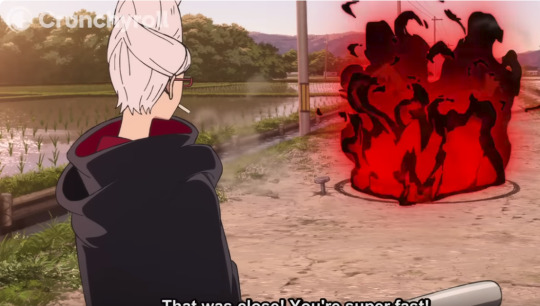
Another major stand out is Inari is a god of messages (done through her foxes).

And one of the very few lessons we see from Seiko is her teaching about the power of words.
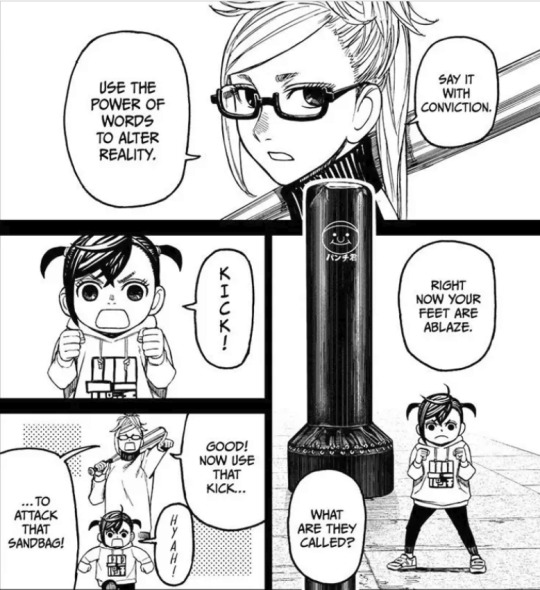
For someone who uses words as a means of power, that could go in hand with messages need be heard, loud and clear.
Additionally, Seiko's most iconic weapon is a pencil-bat, the utensil is used for writing (though so far we see Seiko draw with it more).

Inari is tied to prosperity and food (mainly rice, sake, and tea), this could work off Seiko's need to feed everyone post a victory despite grumbling/having fits about it.
youtube
Other additional details to add that are minor but still stood out to me.
Seiko's power sets yokai ablaze in a ghostly fire, which could be a nod to fox fire.
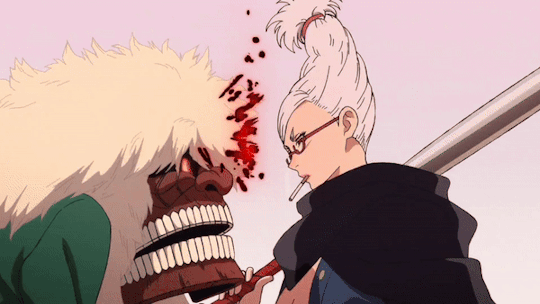
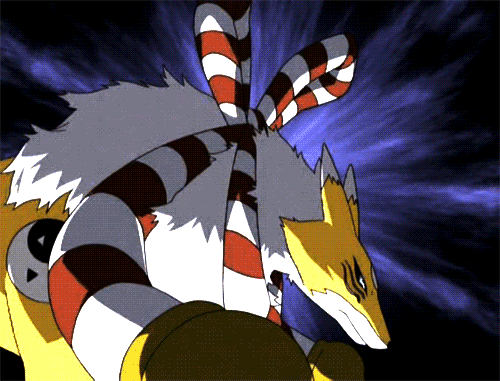
Seiko works with nails and a metal bat and is a warrior/martial artist, and Inari is a patron of blacksmiths and protector of warriors.
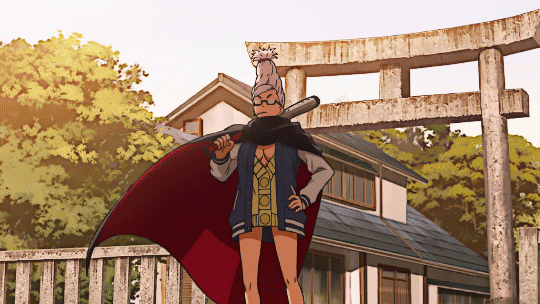
Inari's origins has them coming down from the heavens, and Seiko's name literally means star child.

Foxes are animals commonly tied to being wise, clever, mischievous, and secretive. A lot of this matches with how Seiko is. She likes to mess with Momo (at least I think at this point her refusing to believe in aliens is just to mess with Momo).

Seiko will also keep secrets from Momo. Sometimes for her safety, sometimes to mess with her.

Lastly, Inari is most noted to work with white foxes, who often have red markings especially on the face.

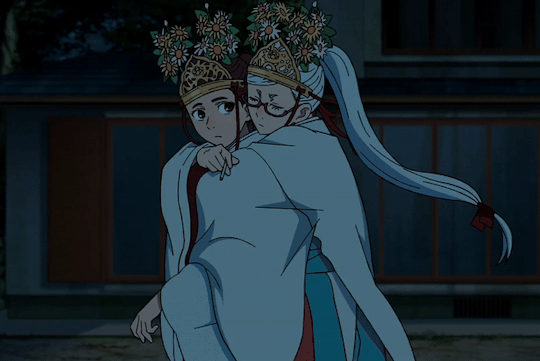
And there's Seiko notably having white hair, which may be a reflection of her age, may be that she's a silver vixen. And to add to the kitsune visual, Seiko does have red glasses which could work off red markings on the face.
Chances are good this is all a reach, especially as I would think we'd see some fox imagery around the Ayase residence (unless the rice fields would count?), but there's some details and possibilities that just kinda stood out to me on maybe Inari Okami being the god Seiko mainly works with. As I am surprised that we're almost at Ch 180 and still don't know what god has Kamigoe City as their domain.
And this is all because I saw @heremob draw Momo as a fox and it sent me down this speculative rabbit hole and see the potential ties the Ayases may have with foxes, and by extension, Inari.
84 notes
·
View notes
Text
Solar farms don’t just have to be about low carbon electricity, they could also help reverse biodiversity decline. Under appropriate management and the right policies, solar farms have the potential to deliver benefits for nature and climate. Our team’s research on solar farms across the UK shows that these energy facilities can boost local pollinator populations and enhance pollination services to adjacent crops. For instance, managing solar farms as wildflower meadows can benefit bumblebee foraging and nesting, while larger solar farms can increase pollinator densities in surrounding landscapes compared to smaller sites managed as turf grass. Solar farms have been found to boost the diversity and abundance of certain plants, invertebrates and birds, compared to that on farmland, if solar panels are integrated with vegetation, even in urban areas. Solar farms can also deliver multiple “ecosystem services” in addition to biodiversity conservation, including food production and support for rural activities such as recreation. Yet, as with any changes, there will be winners and losers. Some species, such as bats, find it harder to forage for insects and travel along protected corridors of habitat due to to the presence of solar farms. The jury is still out on whether solar farms change the soil’s capacity to store carbon. With clearer understanding of how different species respond to the presence of solar farms, the design, location and management of these facilities can be adapted accordingly to benefit nature. Solar farms may challenge some deeply held perceptions in the UK of a cultural “green” countryside dotted with lush farmlands in which wildlife co-exist in apparent harmony with human-dominated land uses. However, centuries of agricultural intensification have pushed several species and habitats to the brink in the UK, a nation that’s been highlighted as one of the most nature-depleted countries in the world.
12 August 2024
129 notes
·
View notes